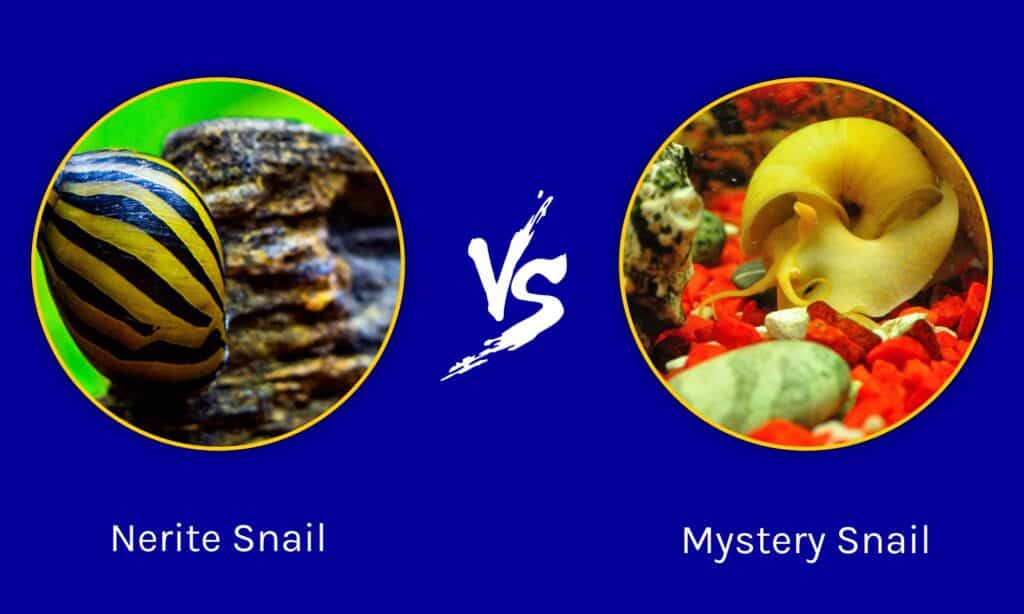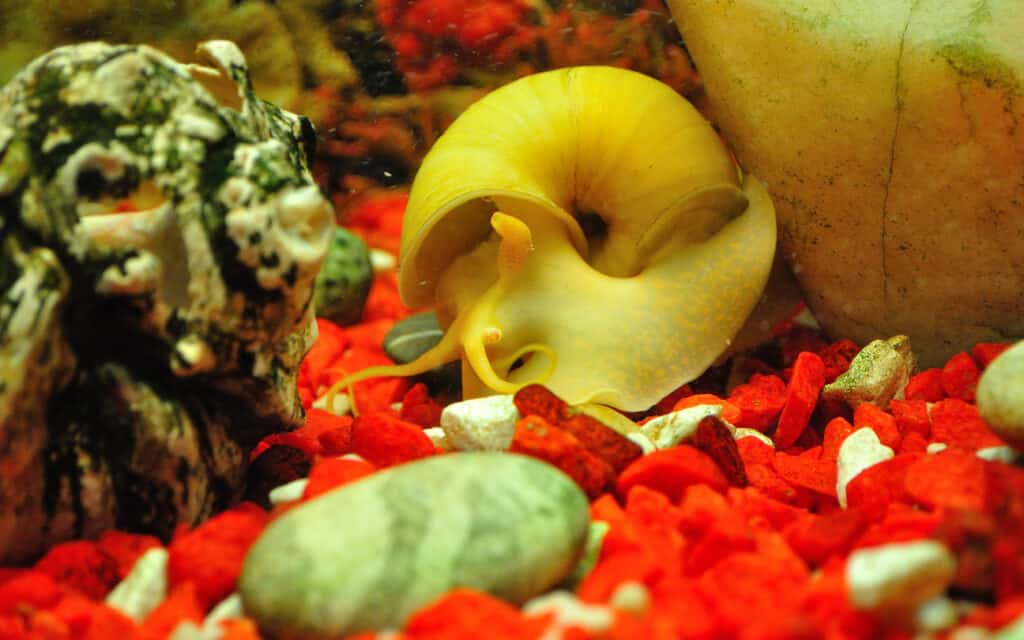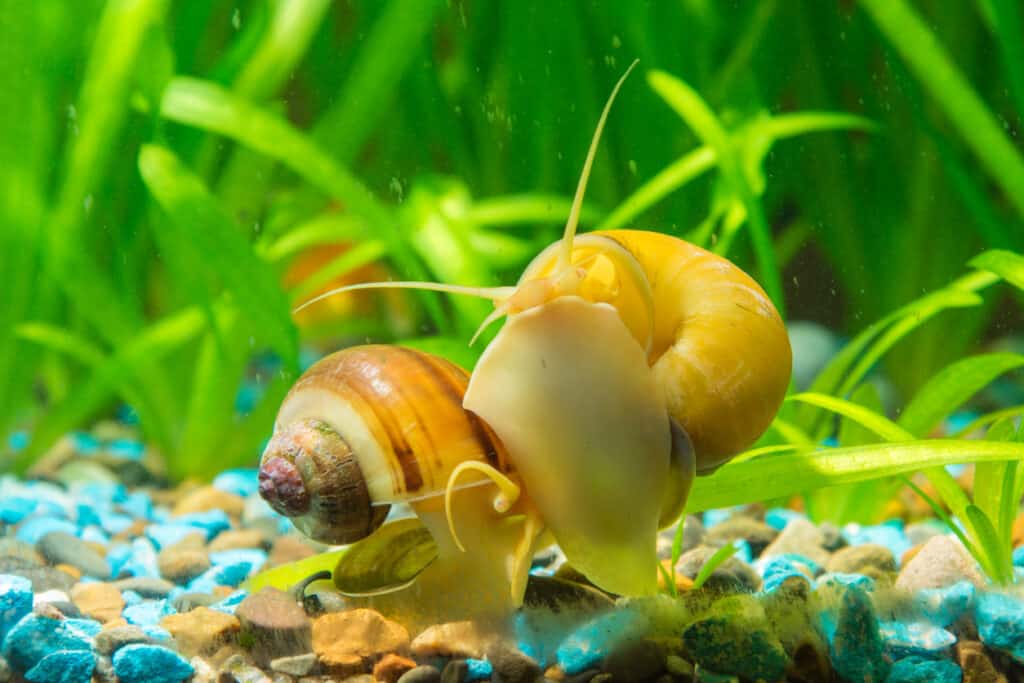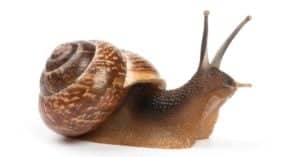Do you have a nerite or a mystery snail? Do you plan to buy one? Or maybe you already have both and want to find out more about them – how to tell them apart, how to feed them properly, or how to make them more comfortable to enjoy their lives together in the same tank?
Whatever the case, you’re right where you need to be, as we have everything you need to know on this topic!
Comparing Nerite Snails vs Mystery Snails

| Key Differences | Nerite | Mystery Snail |
|---|---|---|
| Technical term | Family of snails | Species of snails |
| Size | 0.5-1 inches | 1-1.5 inches long |
| Colors | Nearly black, dark green, dark brown, olive green, reddish-brown, stripes, dark round dots, black ridges | Darker shades, black, brown, blue |
| Diet | Detritivore, herbivore | Omnivores |
| Lifespan | 1-2 years | 1-3 years |
The Key Differences Between Nerite Snails and Mystery Snails
The key differences between nerite snails and mystery snails are taxonomy, size, color, health issues, and lifespan.
Let’s explore these differences in detail!
Nerite vs Mystery Snail: Taxonomy

Nerite is a common name for
Neritidaeand is a family of small to medium snails that live in saltwater and freshwater.
©Joan Carles Juarez/Shutterstock.com
The first distinction worth mentioning has to do with taxonomy. Nerite is a common name for Neritidae and is a family of small to medium snails that live in saltwater and freshwater. Their main characteristic is that they possess a gill and an operculum. The nerite family includes various species of snails that can be easily accommodated in your tanks, such as the tiger nerite snail, black racer nerite snail, or zebra nerite snail.
Mystery snails, on the other hand, are specified in the Ampullariidae family. The common name for the Ampullariidae family is apple snails. It is a family of large freshwater snails. People often think that apple snails are the same as mystery snails, but that’s not true. Mystery snails are indeed apple snails, but not all apple snails are mystery snails. The most important characteristic to help you tell them apart is that the mystery snail never grows bigger than 1.5 inches.
Nerite vs Mystery Snail: Size
Both nerite snails and mystery snails are small types of snails. Mystery snails, however, can grow bigger than nerite snails.
There isn’t an exact number to define a nerite snail because it depends on the species. The olive nerite snail, for example, is a small species, measuring 0.5 inches on the smaller side. The zebra nerite snail and the tiger nerite snail are larger species, growing twice as big as the olive nerite snail. The smallest nerite snail species is the horned nerite snail. Its smaller side measures 0.25 inches and the largest 0.5 inches.
While nerite snails are usually as big as a dime or a quarter, mystery snails can reach up to 1.5 inches.
Nerite vs Mystery Snail: Color

Nerite snails can have black, dark brown, olive green, dark green, golden, or reddish-brown shells.
©iStock.com/Juan Carlos Juarez Jaramillo
The shell color is an easy way to check if the snail is a nerite snail or a mystery snail.
Nerite snails can have black, dark brown, olive green, dark green, golden, or reddish-brown shells. Many nerite snail species are extremely polymorphic, meaning that they have patterned shells – they may be decorated with stripes, dark green or black ridges, or tiny dark round dots. In any case, nerite snails can have a pretty large number of color combinations. This makes it easier to spot them among mystery snails. Evidence says that this coloration may be caused by the “stimulation of the snail mantle’s secretory cells by the activity of the animal’s central nervous system.”
Mystery snails do not usually have patterned shells. For instance, they feature combinations of colors but not stripes or dots. Mystery snails are usually dark colors – brown, black, or blue. They have white or dark slate feet.
Nerite vs Mystery Snail: Diet
Nerite snails are herbivores and detritivores, and they love algae, mainly green spot algae, hair algae, brown algae, or green dust algae. If you decide to get a nerite snail, you can rest assured that your tank will always be clean and shiny, as they’ll work their way around it all day long!
You can also feed your nerite snail with algae wafers. Other things nerite snails like include vegetables, such as carrots or zucchini. It’s important to blanch the vegetables before giving them to the snail.
The diet of a mystery snail is pretty much the same. Mystery snails also like algae but are not as crazy about them as nerite snails are. You can feed your mystery snail with blanched carrots, peas, spinach, cucumbers, or zucchini. You should also have calcium test kits at hand because mystery snails are prone to shell cracks. You might need to provide them with a diet rich in calcium to prevent this.
Nerite vs Mystery Snail: Health Issues and Lifespan

Mystery snails can live longer than nerite snails.
©iStock.com/delobol
Nerite snails and mystery snails can get sick if the water tank is not adjusted according to their needs.
Here are some tips on how to check if your snail is sick:
- Swollen or discharging foot: this can be caused by chemicals in the water, such as various plant fertilizers or anything containing copper. If you notice this, just make sure to fix the water so that the problem doesn’t get more serious.
- Tip-toeing: if your snail is tip-toeing, the snail is pretty old and will soon die of natural causes.
- The operculum closing: if your snail is sick, the operculum will not close as needed. A small opening means there’s something wrong, while a larger opening means that your snail is extremely ill or dying.
- Mantle collapse: this is a serious health issue appearing when the shell of the snail is fully or partially detached from the mantle.
- Floating: some snails float when they are too weak for any other kind of movement. This doesn’t mean yet that they are sick, but just make sure you check them from time to time.
It is considered that mystery snails can live longer than nerite snails – up to 3 years longer. Nerite snails usually don’t live longer than 1-2 years, even if you take perfect care of them.
Can nerite snails live with mystery snails?

Mystery snails are friendly, peaceful, and good at sharing their territories with other tank mates.
©iStock.com/Madhourse
Nerite snails and mystery snails are friendly, peaceful, and good at sharing their territories with other tank mates. So, these two would be happy to live together. The nerite snail will do the cleaning and maybe share some algae with its mystery friend, while the mystery snail will check all the hiding places in the tank. They’ll definitely have some fun together!
The photo featured at the top of this post is © Mark Brandon/Shutterstock.com
Thank you for reading! Have some feedback for us? Contact the AZ Animals editorial team.






